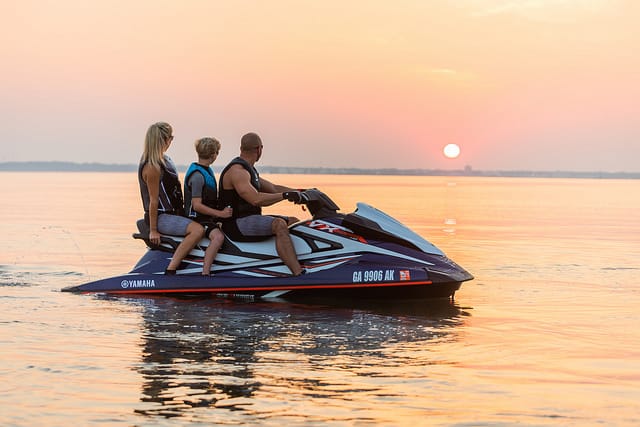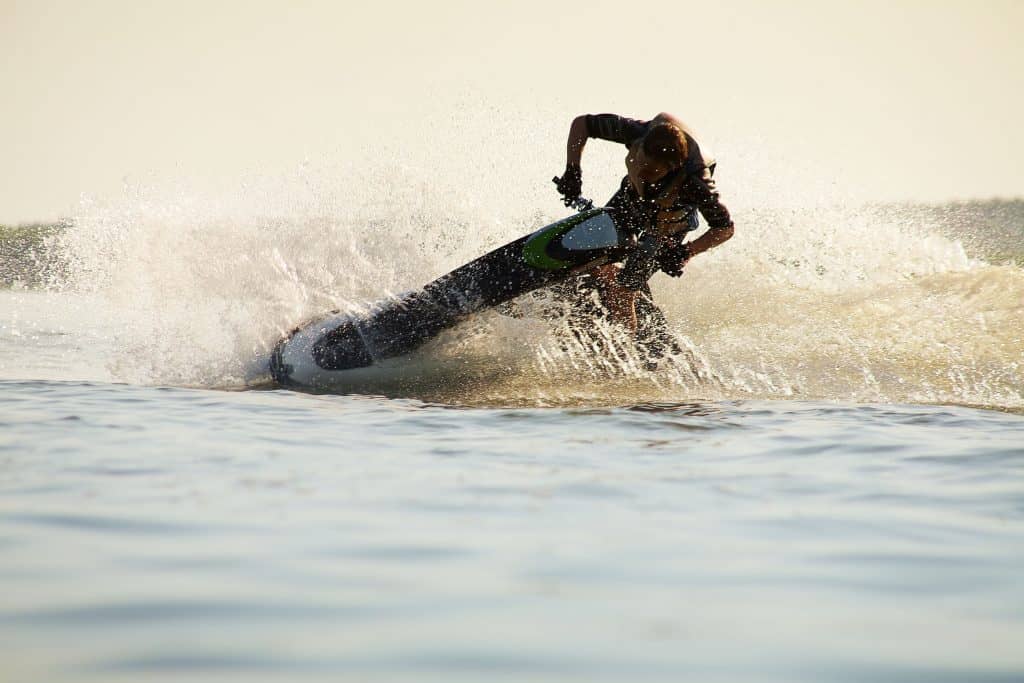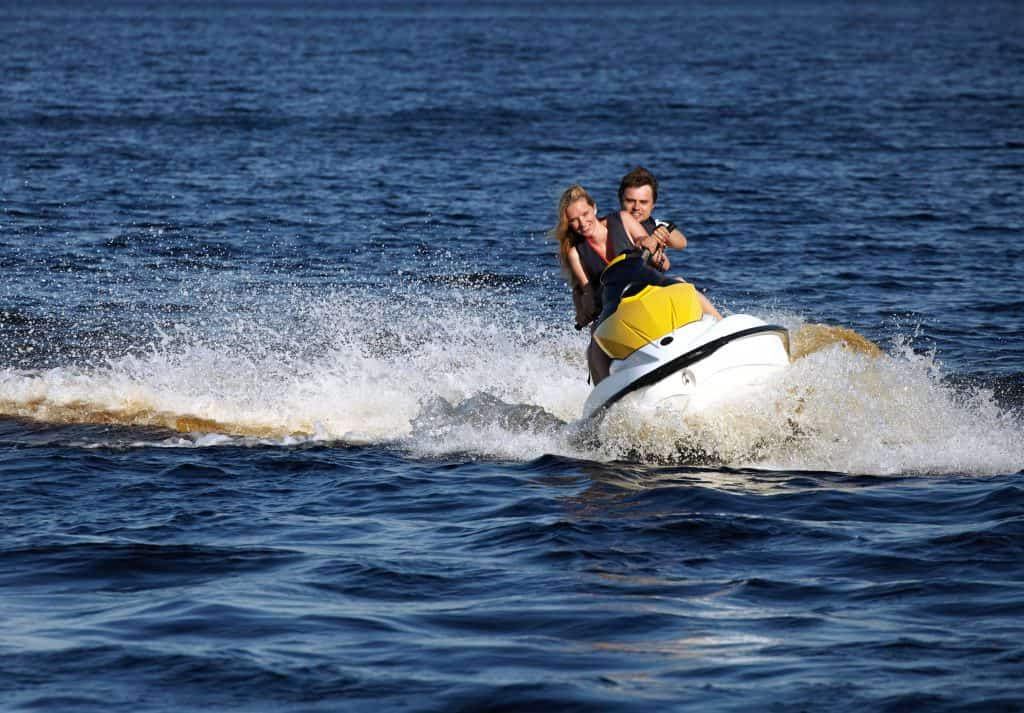Jet skis are a great way to spend time on the water in the summertime and create some memorable times with family and friends. Though jet ski laws can vary from state to state and it is a need-to-know in order to be able to enjoy your time on the water.
Anyone under the age of 12 cannot operate a PWC even if they have completed the boating education certificate. Though anyone between the ages of 12 and 15 years of age can operate a PWC if they are under the supervision of someone 18 years of age or older.
It is important to be aware of the following regulations and laws for riding a jet ski on the water within the state of Ohio. By doing so you are responsibly following the law and that will guarantee you have an adventurous and stress-free time on your jet ski with family and friends.

Registering Your PWC
Ohio Registration Fees
| LENGTH OF BOAT | POWERED BY MOTOR | POWERED BY SAIL ONLY (NO MOTOR) |
| Any boat less than 16′ long | $33.00 | $38.00 |
| Boats 16′ long but less than 26′ long | $48.00 | $53.00 |
| Boats 26′ long but less than 40′ long | $63.00 | $68.00 |
| Boats 40′ long but less than 65′ long | $78.00 | $83.00 |
| Boats 65′ long and longer | $93.00 | $98.00 |
Numbers and Stickers
Once you receive your registration number and the validation stickers you must display these items in the following ways:
- The cannot be any other numbers shown on the bow of your vessel
- The letters have to be separated from the numbers with space or hyphen
- Each number has to be painted, applied onto your vessel as a decal, or place to be shown on both sides of the bow
- The numbers must be read from left to right on both sides
- Each number must be in block letters and three inches high
- The color of your numbers must also be in contrast with the background of your vessel
Hull Identification Number
A Hull Identification Number (HIN) is a 12-digit number that is assigned by the manufacturer to vessels built after 1972. They help be able to determine the difference between multiple vessels.
In case your vessel is stolen you should write down your HIN number and put it somewhere safe.

The Basics
Personal Watercraft Rules and Regulations
- You must have a whistle or horn on board your PWC that is U.S. Coast Guard approved
- You cannot remove any backfire flame arrestor or ventilator if it is installed by your manufacturer
- You cannot operate a personal watercraft vehicle within 500 feet of a designated swim area
- Reckless operation of a PWC is not allowed. Examples of this are:
- Jumping a wake too close to other vessels
- Last minute avoidance of collision
- Weaving carelessly through vessel traffic
- Carrying more passengers on your PWC than is recommended
- If you maneuver your PWC in such a way that it can cause unreasonable harm to you or your passengers
- Each person on the PWC must wear a U.S. Coast Guard approved type 1,2, or 3 personal flotation device
- It is illegal to operate a personal watercraft vehicle between the hours of sunset and sunrise especially when your vision is a bit restricted
- The safety ignition switch must be fully functional and have a lanyard attached to it ensure it does not get lost or misplaced
Reckless Operation of a Vessel
Failure to Regulate Your Speed
This is operating your vessel at a faster rate than recommended, especially during vessel traffic, poor weather condition, and closeness to shore. Some example of this is:
- Operating your vessel at extreme speed in the close vicinity of another vessel, PWCs, or dangerous waters
- Operating at a greater speed than “slow, no wake speed” that is posted in a “no wake” zone
- Going faster than the speed limit posted near the body of water you are operating on
- Going at a speed that can be harmful to your vessel
Improper Distance Between Others
If you are operating your vessel faster than 5 mph while operating within 100 feet of the shore, dock, pier, raft, float, or an anchored or moored vessel you are operating your vessel improperly and putting others around you at risk.
Riding on the Bow, Deck or Gunwale of a Vessel
Riding on anything that is not equipped with fixed seating can lead to the potential of falling overboard. Do not allow your passengers or yourself to sit on a seat back, transom, gunwale, seats on raised decks or a bow.
Reckless Operation Specifics
This is when you weave through traffic, swerve last minute to avoid a head-on collision with another vessel, or overload your vessel beyond the capacity it states on the plate.
Unsafe Conditions
Not having enough personal flotation devices, fire extinguishers, backfire flame arrestors, ventilation systems, or navigational lights are putting yourself and others abroad your vessel at risk.
You also put yourself and others in danger when you overload or overpower your boat, or when if you are operating the vehicle while intoxicated.
Alcohol and Drugs
Ohio state law considers a person to be under the influence while boating if: their blood alcohol concentration is 0.08% or greater or if they are under the influence of controlled substances and drugs that can render you incapable of operating a PWC.
Being under the influence can cause you to experience one of the following:
- impaired balance
- blurred vision
- poor coordination
- impaired judgment
- and slower reaction time
Ohio can fine you for serious penalties if you are found operating under the influence of alcohol or drugs. You may also face jail time for failing to follow the law.

Required Equipment
Personal Flotation Devices
| Type 1 | Offshore Life Jackets | This vest can turn an unconscious person in the water to face up in the water. It was made for rough waters and for situations where rescue might take a long time. |
| Type 2 | Near-Shore Vests | This vest is fit for calmer waters and faster rescues. If you were to wear this while unconscious it may not be able to turn your face up in the water. |
| Type 3 | Flotation Aids | This vest can also be a full-sleeved jacket and it is great for calm waters and fast rescues. This will definitely not turn your face up in rough waters. This is generally worn for water sports. |
| Type 4 | Throw able Devices | This type of flotation device is a cushion or ring buoys and are typically used to throw at someone in trouble. They are not made to last for long hours in the waters, or non-swimmers, or the unconscious. |
| Type 5 | Special-Use Devices | This type of flotation device was made for activities like kayaking, water-skiing These typically look like white water vests, deck suits, and personal flotation device hybrids. |
Personal Flotation Device Requirements
- All PDFs have to be in a serviceable condition and easily accessible
- Any person that is on board a PWC must wear a PFD that is approved by the U.S. Coast Guard
- Vessels have to have one of the 5 personal flotation devices, they also must be wearable and a proper size so that anyone can wear it
- The inflatable flotation devices can be used if the person is 16 years of age or older, can be activated by a pull and if it is U.S. Coast Guard approved
- Type 4 personal flotation devices that are approved by the U.S. Coast Guard must be on board a vessel that is 16 feet or longer and must be easily accessible for emergency use
Fire Extinguishers
You can classify your fire extinguisher by letter and number symbol. The number helps you decipher the size of the extinguisher, and the letter indicates the type of fire that is extinguished as well.
Type A Fires
- are of combustible solids such as wood
Type B Fires
- these are flammable liquids like gasoline or oil
Type C Fires
- this is mainly electrical fires
All vessels are required to have a Type B fire extinguishers on board in the case of any extreme or dangerous situations occurring. Your fire extinguisher should be placed somewhere easily accessible in the case of a situation where it needs to be used immediately.
Enforcement
The boating laws and regulations are enforced by the wildlife enforcement officers of the
- Any vessel that is being approached by an enforcement officer must come to a slow speed to where the vessel can maintain steerage to be able to alter course if told.
- If an officer finds they have enough probable cause to believe you are violating a law, they have the authority to board your vessel
- Officers are also authorized to order the owner/operator of an unsafe vessel to move to shore
- A vessel ordered to stop by an officer must do so immediately and permit the officer to come alongside their vessel
